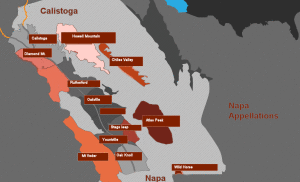
Napa Appellations
An appellation is a recognized wine area. The legal term Is American Viticultural Area or AVA.
The Napa Valley is itself what is referred to as an appellation. Napa Valley was California’s first recognized appellation and the second appellation recognized in the United States. Within the Napa Valley appellation, there are 16 subappellations: Atlas Peak, Calistoga, Chiles Valley District, Coombsville, Diamond Mountain District, Howell Mountain, Los Carneros, Mt. Veeder, Oak Knoll District, Oakville, Rutherford, St. Helena, Spring Mountain District, Stags Leap District, Yountville and Wild Horse Valley.
ATLAS PEAK APPELLATION
Elevation: 760–2600 feet
Climate: Cool-mountain temperatures, about 10–15º cooler
than the valley floor in the summer
Notable for: Basaltic red color soils, volcanic in origin.
Primary varieties: Cabernet Sauvignon, Chardonnay
CALISTOGA APPELLATION
Elevation: 300–1200 feet
Climate: Summer temperatures may peak above 100º and drop
to low 40sº at night
Notable for: Soils of volcanic origin, with rocky clay on the hillsides, and heavier clay-silt in the valley areas
Primary varieties: Cabernet Sauvignon, Zinfandel, Syrah, Petite Sirah
CHILES VALLEY DISTRICT APPELLATION
Elevation: 600–1200 feet
Climate: Summer temperatures reach the mid-80sº, but due to
elevation and evening fog, may drop to below 50º
Notable for: Good fertility on valley and less fertility on the hillsides. Silty-clay soils in the valley and rocky clay on the hillsides.
Primary varieties: Cabernet Sauvignon, Merlot, Cabernet Franc
COOMBSVILLE APPELLATION
Elevation: 100-500 feet (small portion over1000 feet)
Climate: Temperate climate
Notable for: Alluvial deposits and weathered volcanic rock
Primary varieties: Cabernet Sauvignon, Merlot, Syrah, Pinot Noir, Chardonnay
DIAMOND MOUNTAIN DISTRICT APPELLATION
Elevation: 400–2200 feet
Climate: Moderately warm temperatures with less fluctuation than the north
Napa Valley; summer temperatures from 50–90° (10–32°C)
Notable for: Reddish gritty soils of volcanic origin. Tannic, with mineral, and cedary taste. Usually needs aging.
Primary varieties: Cabernet Sauvignon, Cabernet Franc
HOWELL MOUNTAIN APPELLATION
Elevation: 600–2600 feet
Climate: Somewhat warmer and drier due to strong afternoon sun.
Notable for: volcanic soils on and area of low fertility. Tannic, with acidity. Usually needs aging.
Primary varieties: Cabernet Sauvignon, Merlot, Zinfandel, Viognier
LOS CARNEROS APPELLATION
Elevation: Sea level–700 feet
Climate: Cool, high temperatures rarely exceed 80º
Notable for: Shallow clay dominated soil.
Primary varieties: Merlot, Pinot Noir, Chardonnay
MOUNT VEEDER APPELLATION
Elevation: 500–2,600 feet
Climate: Cool to moderate temperatures, with most vineyards above the fog line.
Noted for: Tannic and minerally, but strong flavors. Primary varieties: Cabernet Sauvignon, Merlot, Zinfandel, Chardonnay
OAK KNOLL DISTRICT OF NAPA VALLEY APPELLATION
Elevation: Sea level–800 feet
Climate: Moderate to cool temperatures, with marine air and fog often remaining until late
morning.
Primary varieties: Cabernet Sauvignon, Merlot, Chardonnay,
Sauvignon Blanc, Riesling
OAKVILLE APPELLATION
Elevation: Sea level–500 feet
Climate: Moderately warm temperatures
Primary varieties: Cabernet Sauvignon, Merlot, Sauvignon Blanc
RUTHERFORD APPELLATION
Elevation: Sea level–600 feet
Climate: Moderately warm.
Primary varieties: Cabernet Sauvignon, Merlot, Cabernet Franc, Zinfandel
SPRING MOUNTAIN DISTRICT APPELLATION
Elevation: 600–2600 feet
Climate: Cooler temperatures prevail.
Primary varieties: Cabernet Sauvignon, Merlot, Cabernet Franc, Zinfandel, Chardonnay
ST. HELENA APPELLATION
Elevation: 100–700 feet)
Climate: Warm temperatures, with greater protection from the hills,Primary varieties: Cabernet Sauvignon, Cabernet Franc, Merlot, Syrah,
Zinfandel, Viognier
STAGS LEAP DISTRICT APPELLATION
Elevation: Sea Level to 400 feet
Climate: Moderately warm temperatures, Primary varieties: Cabernet Sauvignon, Merlot, Sangiovese, Chardonnay, Sauvignon Blanc
WILD HORSE VALLEY APPELLATION
Elevation: 600–1900 feet
Climate: Warmer area temperatures.
Primary varieties: Cabernet Sauvignon, Pinot Noir, Chardonnay
YOUNTVILLE APPELLATION
Elevation: 20–200 feet
Climate: Moderate temperatures, with cooler marine air and fog contributing to cooler
mornings.
Primary varieties: Cabernet Sauvignon and Merlot
The Way to Wine is a Road through Walt’s
Walt’s Wine Guide – Napa Valley is your best resource for Wine Tasting Guides and Information.

